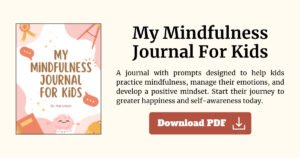Sleep Meditation Training for Kids
 Sleep Meditation Training for Kids and relaxation tools can help children unwind and prepare for sleep. Through body scans, imagination and deep breathing, they are able to relax and self-soothe. Short evening meditation can help improve sleeping patterns.
Sleep Meditation Training for Kids and relaxation tools can help children unwind and prepare for sleep. Through body scans, imagination and deep breathing, they are able to relax and self-soothe. Short evening meditation can help improve sleeping patterns.
If there was one thing that I wished I knew earlier, it’s meditation training. But can it be really taught to toddlers and preschoolers? You do know how hard it is to tell a kid or even an older child to keep quiet and stay still in this era of technological distractions.
The answer is yes.
Teaching meditation early on can help develop healthy coping mechanisms as they grow older. It helps establish healthy sleep routines, instills discipline by practicing limited screen time and teaches them how they can calm their minds.
Teaching kids about how they can take care of their mental health should be taught together with teaching them how to care for their physical self.
But before you continue you might like to consider our free worksheet on exploring “My Mindfulness Journal For Kids”. Please download this worksheet here.
In this Article:
At what age can you teach a child to meditate?
Kids’ Edition: How to teach meditation for sleep
At what age can you teach a child to meditate?
 Laura Vogel, director of therapeutic services at Momentous Institute, mentioned that children aged three to four could already be taught about “breathing techniques that allow them to feel a change in their bodies”. She suggested practicing techniques when the kids are calm so they can effectively use this skill when faced with overwhelming situations.
Laura Vogel, director of therapeutic services at Momentous Institute, mentioned that children aged three to four could already be taught about “breathing techniques that allow them to feel a change in their bodies”. She suggested practicing techniques when the kids are calm so they can effectively use this skill when faced with overwhelming situations.
Vogel suggested that when you teach meditation for kids, you should provide them an external framework of how they can integrate it into their lives. This can be achieved by constant practice or incorporation into the kids’ morning or bedtime routine.
Constant practice at night can teach the toddler’s release excess energy, process their emotional and mental concerns, and find comfort at night.
Kids’ Edition: How to teach meditation for sleep
The first few times that you practiced meditation, I’m quite sure that it’s only either you found it hard to concentrate (because of your wandering thoughts) or you almost dozed off to dreamland.
Cory Cochiolo, a hypnotherapist, and author of a book for kids about bedtime meditation training , suggested that bedtime is a time in which children have the most need to feel secure, loved, comfortable, and happy. He said that establishing a routine is best made and planned with the participating child as the” kids invest in and trust a routine most when they’ve participated in making it.”
The following are some of the tips and bedtime meditation training exercises from his book “Bedtime Meditations for Kids: Quick, Calming Exercises to Help Kids Get to Sleep”:
-
- Let the kids choose their bedtime set-up or environment. Cochiolo encourages that parents should let their children decide their own bedtime environment (pillows, blankets, toys, color of walls, curtain) within reason.
- Encourage them to have their own story choices. Instead of picking a book that you read over and over again, let your child choose what story they want or if they want a made-up story. You can offer them choices that is within your skill or happiness. Letting them choose (even if it is limited to your capacity) give them a sense of calmness, to fall into sleep easier.”You can use your storyline to become sort of a meditation script that they can repeat with you or something that they can listen to.
- Choose the tone and voice that your child likes. You can observe or ask them the accent and tone that they feel comfortable with. Look out for opportunities to change your voice, like hushing or slow down your words. Why? Because hushing and slowing down are natural cues for the body to do the same, drifting toward sleep.
- Keep trying. If your child seems resistant to your efforts of calming them down, try to “sit down with your child at other times and have it be something that’s fun.” Another trick that they recommended is to have a guided meditation playing throughout the child’s bedtime routine.This can be a way to incorporate calming meditation become the soundtrack for comfort and safety. “Don’t make a big deal of it—just leave it playing, and they’ll get used to it.”
- Practice your own gratitude. One of Cochiolo’s favorite activities (demonstrated here by story characters Heidi, Cherry, and Vaya) is the Reassurance Game.This game can be done as you’re cuddling with your child. Basically, you take turns in giving compliments, for example. The parent may say: “I think you are very creative. You drew me last morning!” Now the kid will think of something they can give a compliment to their parent like: “I think you are so loving. You made me a yummy breakfast.”Cochiolo, says that this Game is just one of the ways to “fill up the child’s cup of love.” This helps them relax and fall asleep with the assurance and comfort of being understood and accepted.
Finally, remember that meditations must and can be modified according to the needs and mood of your child. And by talking about mood and needs, we do know that this is likely varied by the hour.
Cochiolo mentioned that there are different meditation trainining that is designed for the child’s different needs like:
- to release excess energy before bed,
- a means to encourage talking about their day,
- what they think about and what confuses them at the moment.
All the different meditations aim to help kids feel better and be more aware and accepting of their bodies and help calm their thoughts.
You can check out the following free resources for bedtime meditation for kids:
 New Horizon Meditation & Sleep Stories — YouTube channel and app for children and adults full of guided meditations aimed to aid with sleep.
New Horizon Meditation & Sleep Stories — YouTube channel and app for children and adults full of guided meditations aimed to aid with sleep.
Stop, Breathe & Think —This focuses on fun activities and meditations, this application is designed to help kids ages 5-10 in achieving focus for quiet, peaceful sleep and a platform to process their emotions. This application also teaches about mindful breathing (which is considered the easiest form of mindfulness and meditation).
Cory’s Conscious Living — This YouTube channel contains 500 meditations for children, a true favorite of kids, as it is around recurring characters and themes, which basically, in the eyes of children, is just a mere form of “cartoons.”
Sleep meditation for kids is best introduced in a bedtime setup as it can be easily included as a routine before sleeping. Will you now be ready to teach meditation to your mini versions of you?
If you’re ready to help your child develop healthier sleep routines and emotional well-being, download our free ‘My Mindfulness Journal for Kids’ and start guiding them to a peaceful night’s sleep today.







